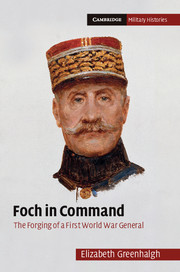The French Army and the First World War
£68.00
Part of Armies of the Great War
- Author: Elizabeth Greenhalgh, University of New South Wales, Sydney
- Date Published: November 2014
- availability: Available
- format: Hardback
- isbn: 9781107012356
£
68.00
Hardback
Other available formats:
Paperback, eBook
Looking for an inspection copy?
This title is not currently available on inspection
-
This is a comprehensive new history of the French army's critical contribution to the Great War. Ranging across all fronts, Elizabeth Greenhalgh examines the French army's achievements and failures and sets these in the context of the difficulties of coalition warfare and the relative strengths and weaknesses of the enemy forces it faced. Drawing from new archival sources, she reveals the challenges of dealing with and replenishing a mass conscript army in the face of slaughter on an unprecedented scale, and shows how, through trials and defeats, French generals and their troops learned to adapt and develop techniques which eventually led to victory. In a unique account of the largest Allied army on the Western Front, she revises our understanding not only of wartime strategy and combat, but also of other crucial aspects of France's war, from mutinies and mail censorship to medical services, railways and weapons development.
Read more- A comprehensive, revisionist account of the French army's contribution to Allied victory in the Great War
- Covers strategy and operations throughout the war and across all fronts
- Based on a wide range of French and English-language sources
Awards
- A Choice Outstanding Academic Title 2015
Reviews & endorsements
'There's far too much in this book to summarize here, but let it suffice to say that this is an essential read for anyone interested in the Great War.' A. A. Nofi, The NYMAS Review
See more reviews'The Anglophone military history of the Great War runs something like this: French generals callously massacred their own infantry in fruitless offensives in 1914–15; the French poilus heroically held Verdun in 1916; and in 1917, an exhausted French Army came near to collapse, only to be rescued by a revitalized British Army, the Americans, and the tanks. Greenhalgh's impressive new work provides an important corrective to this myth. The French Army was, in fact, the linchpin of the entire Allied effort, and the story of its victory is central to understanding the real war. Based on printed primary sources as well as archival research, the volume offers not only a comprehensive history of the army's operations on multiple fronts, but adds significant detail on the mobilization of French manpower to sustain a war of attrition fought primarily on French soil … This fine book is an important corrective to most Great War narratives. Bottom line: mandatory for modern history collections. Summing up: essential.' G. P. Cox, Choice
'A cogent and eminently readable rebuttal to the inaccurate stereotypes that have long dominated non-specialist view of the French Army in World War I. She shows a French Army that was flawed, but whose officers and men continually sought new ways to overcome the momentous challenge they faced.' Andrew Orr, H-France
'The French Army and the First World War is a tour de force and will remain the single best book on its subject for the foreseeable future. Enhanced by well-chosen photographs, detailed tables, and a helpful, concise bibliographic essay, it is essential reading for all students of the French military, World War I, and military history in general.' Michigan War Studies Review
'Elizabeth Greenhalgh has written an indispensable book on France in the Great War. In fact, the book is indispensable more broadly to the history of the First World War, and to the history of modern France.' Richard Fogarty, H-War
Customer reviews
17th Oct 2024 by UName-144117
In a conflict where the French bore the largest burden on the Western Front, the English speaking historiography of the Great War is scant on books dealing with the French contribution. Naturally our focus on that conflict is predominantly Anglo-centric and consequently our knowledge is skewed to a largely nationalistic flavour, depending on the author’s allegiance within the British Commonwealth, having little regard for the contribution of other nations. Most pay only passing mention of the French Army’s fighting - rare exceptions being Selwell Tyng’s superb The Campaign of the Marne, and Alastair Horne’s acclaimed The Price of Glory: Verdun 1916. Similarly, sound English versions on the wider French contribution during the war are few and far between, among the best being Smith, Audoin-Rouseau and Becker’s France and the Great War, 1914-1918, Robert Doughty’s outstanding Pyrrhic Victory: French Strategy and Operations in the Great War, and Elizabeth Greenhalgh’s excellent Foch in Command: The Forging of a First World War General. All provide a welcome balance, bringing a broader perspective to the fighting that occurred during that terrible catastrophe Elizabeth Greenhalgh has established herself as a leading historian on the higher direction of the Great War and the French contribution to it - her Victory Through Coalition Britain and France during the First World War bringing a new perspective to that subject, rather than the largely British focus we have been fed for years, while her aforementioned Foch in Command provides a welcome balance to the military direction of Allied strategy and operations on the Western Front. Now she delivers another valuable contribution with The French Army and The First World War, a volume in Cambridge University Press’s ‘Armies of the Great War’ series. Like Doughty’s Pyrrhic Victory, her work is pitched at the strategic and operational levels of the conflict, but while Doughty largely confines his narrative and analysis to the military aspects, Greenhalgh paints on a wider canvas, taking us into other facets, especially the political machinations behind the scenes, and analyses of the French Army not normally addressed, such as morale, armaments, discipline, and the famous mutiny of 1917. Commencing with a study of the pre-war army, set within the fraught political tensions of the period, and the relationships with Russia, Britain and Germany, the book is divided into ten chapters. Eight address the war years 1914-1918. Whilst 1914, 1915 and 1916 are each covered in one chapter, the last two years each have two, with a penultimate chapter covering the last month of hostilities, the armistice and demobilisation. The book concludes with a wide-ranging overview of the army and associated issues during the war years, and their impact on France after the war. This is not simply another narrative primarily devoted to the French Army’s operations, but considers them against a broader background. Chronological in its narrative, Greenhalgh weaves her story around the principal offensives year by year, placing her discussion and observations in the context of the wider political issues, infighting amongst the French higher command, morale and discipline within the army, armaments, social issues and the impact of international considerations, operational results and the enormous casualties suffered at the front. Throughout, the development of new tactics, the need for new weapons and organisations to meet the challenges confronting the Army are discussed, together with an analysis and assessment of the offensives undertaken, highlighting the Army’s strengths, weaknesses, failures and achievements. Thus we are provided with a rich tapestry not only of French strategy and operations, and organisational and tactical developments, but also the influences that drove them. In doing so, Greenhalgh brings some contentious issues into perspective that are rather different from those of the perceived wisdom handed down by less well researched tomes. For example, her findings on the mutiny of 1917 are surprising, and suggest the discontent amongst the troops was not as widespread as previously thought, and their actions were motivated by other matters, rather than just simply the oft-quoted disillusionment with the Nivelle Offensive. She points out the incidents of disobedience occurred after Nivelle was replaced as CinC by Petain. Moreover, having already discussed morale, discontent and executions in 1914 and 1915, the perception of the mutiny and its subsequent executions in previous accounts, and the popular culture, appear overblown. While the main focus of operations is on the major offensives and battles on the Western Front, the ferocity of some of the lesser known actions such as the bitter and futile fighting over prominent peaks in the Vosges and sectors further north are briefly discussed, demonstrating that even in quiet sectors the fighting was brutal and costly. Nor is this study confined to the Western Front French participation in the ill-fated Gallipoli campaign, and operations in Africa, Salonika and Italy are addressed, highlighting the wider political realities when determining strategy and operational commitments. But what makes this work especially useful are the discussions of matters percolating behind the front: the inter- allied relations and considerations, the political machinations, the personalties within the French Army and their influences on events - the underlying factors that drive strategy and operations that are often forgotten or glossed over. No-where is this more evident than in the appointment of Nivelle and his ill-fated and universally condemned Offensive of 1917. While acknowledging Nivelle failed to deliver his expectations and that his tenure as CinC, was a disaster, Greenhalgh is less critical of the man than others, pointing out the difficulties he worked under, some being self imposed, but others initiated elsewhere: the political interference and pressure he experienced, the difficulties with the British CinC Haig, the open opposition to his plan within the French Army hierarchy, and being continually undermined by his subordinates, especially Petain. While his offensive did not remotely achieve what he trumpeted it would, Greenhalgh highlights it was more successful and less costly than Joffre’s earlier Champagne Offensive. The ‘disaster’ was more in the perception of the politicians than in the reality of events, being largely another costly battle achieving limited results in a long line of unfulfilled French expectations. Yet again, Greenhalgh brings a perspective to a particular subject that other authors have failed to do. Numerous tables covering diverse issues such as military rates of pay, casualties and losses during the first eighteen months of the war, shell and weapon production, military organisations, density of guns, and comparisons of artillery in 1914 and 1918 support the narrative. A major criticism of most military histories is the absence of good and detailed maps, an essential item if the reader is to easily follow the details of the narrative. This book is no exception, and while 15 maps are provided they are generally large scale providing an overview of the offensive each depicts, making it difficult to follow the detailed operational events described and which, unfortunately, detracts from an otherwise excellent book. It is hoped that in future, CUP and other publishers, will recognise the value in plentiful and good maps to support operational narratives. Overall, this is a fine, frank and comprehensive study of the army that bore the brunt of the fighting on the Western Front, particularly in the first three years of the war, the major battles it undertook, and the influences that directed its strategy and operations. Rich in information and insight, it is a welcome addition to the English language historiography of the Great War, providing a thoughtful and insightful view of the French Army’s participation and performance in the catastrophe that engulfed Europe a century ago.
Review was not posted due to profanity
×Product details
- Date Published: November 2014
- format: Hardback
- isbn: 9781107012356
- length: 486 pages
- dimensions: 236 x 147 x 23 mm
- weight: 0.88kg
- contains: 38 b/w illus. 15 maps 17 tables
- availability: Available
Table of Contents
Introduction
1. The pre-war army
2. 1914: from the frontiers to Flanders
3. 1915: on the offensive
4. 1916: Verdun and the Somme
5. General Nivelle and his 1917 offensive
6. Restoring the Army
7. 1918: German offensives
8. The path to victory
9. Armistices and demobilisation
10. From 1914 to 1919: aux armes, citoyens!
Bibliographic essay
Index.
Sorry, this resource is locked
Please register or sign in to request access. If you are having problems accessing these resources please email [email protected]
Register Sign in» Proceed
You are now leaving the Cambridge University Press website. Your eBook purchase and download will be completed by our partner www.ebooks.com. Please see the permission section of the www.ebooks.com catalogue page for details of the print & copy limits on our eBooks.
Continue ×Are you sure you want to delete your account?
This cannot be undone.
Thank you for your feedback which will help us improve our service.
If you requested a response, we will make sure to get back to you shortly.
×
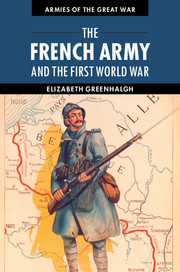

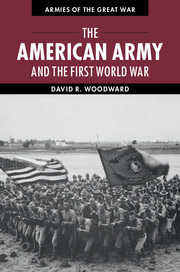

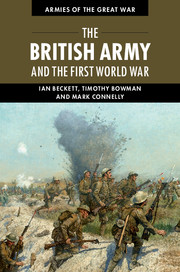
.jpg)
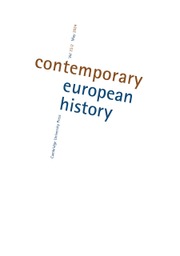
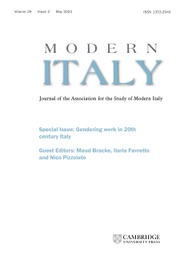
.jpg)

